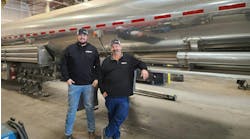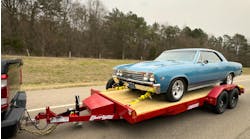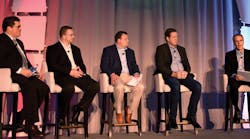What do customers need? It’s the essential question for any business. And for those in freight transportation in the developing e-commerce age, the question increasingly leads to the front door of the consumer. The solution to the growing expectations of fast, cheap home delivery is a smarter supply chain, and that means connected, efficient equipment.
A Friday session at the TTMA convention, “The Road Ahead: A Fleet Panel Discussion,” took a deep dive into carrier equipment needs, and fleets willingness to invest in new technologies—but these new technologies have to deliver. Trailer manufacturers and suppliers, take heed.
The panel, moderated by Bill Sullivan, executive vice president of advocacy for the American Trucking Associations, included:
- Lee Long, director fleet services for Southeastern Freight Lines
- Paul Smith, trailer rebuild manager for Prime Inc.
- Tommy Cottingham, director of maintenance and equipment procurement, J.B. Hunt Transport Inc.; and
- Randy Strutz, president, Quality Distribution.
Manufacturers want to ensure that they’re providing the best equipment to meet a customer’s needs. Besides lowering prices, what do you all view as the most important qualities that manufacturer brings? And what types of features and capabilities are you looking for in their product offerings?
Long: The thing that is most intriguing to us as an industry is how the trailer with a box on wheels can communicate effectively to the back office of our operation. And typically what we see is every manufacturer is pursuing an opportunity to allow a trailer to deliver information loaded up into the cloud. When you think about an operation such as ours [in LTL], we pretty much know where our trailers are every day, we can touch them. But if that trailer had the opportunity to communicate with our cab, which 99% of the time is our equipment, we can actually communicate more effectively with the driver in the vehicle. I think that the communication aspect is becoming very critical in the future.
Strutz: So we look at this a little bit differently [as a bulk carrier]. Our trailer average age is probably 17 years, which is not unusual in our industry. There are two things for me: One, as we see improvements in trailer technology and telematics, the ability to retrofit any kind of upgrades to our fleet is really important, because we have such a legacy fleet of trailers that go back 30 years.
The second thing, as we buy trailers—and we’re making the decision to buy trailers that are going to last us for 30 years—it’s really important for our suppliers to be able to hit our delivery schedules. Because, again, when you’re buying an asset that lasts that long, that cost me three to four times of standard box trailer, we really we plan our resources very tightly.
Smith: An important part of trailers for Prime is repairability. A way for us to control our cost is to be able to repair the equipment. Stuff’s not always engineered to be repaired, so we tend to partner with people that really work with us on repairability side.
Cottingham: On the telematics side, you’re seeing a lot of sensors come out. And we need that data in our back office. The problem that we’re seeing is, the folks that are developing those sensors to communicate lights out or wheel-end issues are also developing their own telematics. We already have a telematics provider, and we really need those guys that are developing those sensors to work their existing telematics provider, as opposed to forcing down the road to having two or three telematics providers.”
Another issue is timeliness of equipment. We’ve got a very, very large, dedicated fleet. And the timeline of getting that equipment delivered is often dictated to us by the customer. Everybody knows what lead times are for dry vans and reefers right now, but oftentimes that doesn’t work for the customer. We just signed that contract, so it’s very important to us that we’re able to work with an OE that can get us equipment sooner than what the standard lead times are in the industry.
What new trailer technologies and innovations are you looking for in the next decade? Are you working with your suppliers toward those technologies?
Strutz: For us in the bulk world, we move all kinds of chemicals with significant varieties of temperature requirements. One of the things our partner OEs can focus on is advanced temperature monitoring equipment, so that we can tell what’s happening to the thermal profile of the product, while it’s going 2,000 miles from Houston to Seattle. How do we enhance that, as far as temperature and maybe some other features, as well as the locations?
Smith: We’re constantly looking at ways to get information from the trailer directly back to us, not relying on the drivers to get stuff in real time. And instead of identifying whether it’s a wheel end or an inflation problem, if it’s an inflation problem we want to know what position it is. And we want to be notified, not just the driver. We want the driver to be aware of it so they can pull over and stop, but we want to also be able to interact with the driver immediately if you see an issue.
That does create a create an issue with us because there’s a lot of new technology out there—there’s a lot of good opportunity for us to be able to do these things—but, unfortunately, they don’t partner with the telematics that we use. So at that point you’re looking at adding another module or something to communicate over cell signal. We want to be able to use the telematics that we already have on there. So we tend to go towards the opportunities that communicate with what we’ve got.
Cottingham: Lighter weight equipment is a big deal we’re always looking at. A lot of the truck OEs come out with a little bit of weight savings here and there. So lighter weight equipment without sacrificing the robustness of the equipment is something we’re always looking for.
Secondly, with the way the digital freight market is going, we need a way to secure the trailer. We’ve got folks that will pick up our trailers and we know they’re moving—we can see it through our telematics—but we’d really like a technology that locks and trailer keeps unauthorized use from occurring.
Long: In our business, we have a lot of irregular freight, and by that I mean it’s a different size no matter what we pick up. What do we need to spec new equipment? It comes from innovation like lift-deck systems; it’s about efficiency on the dock, about getting equipment loaded quickly. It’s about building a better trailer from the floor up—the floor specifications are something we’ve got to do—even from the way we spec our tires, and spec’ing the way we maintain that equipment.
The technology is advancing so quickly in regard to electronics that our technicians are really struggling with repair orders. Even the simplest things confound those guys have been in the business for many years. So I think as we go through the process, we need to make sure that we pull our technicians along with the industry and innovations that are being provided right now.
How do you see government regulations, such as the proposed greenhouse gas emissions rules, affecting your operations and your equipment purchasing?
Long: We actually have to look at the way we have been ordering equipment. Some of our P&D trucks, which is about half of our fleet, we maintain those in the fleet for 12 years. Is it the smart thing to do, with technology evolving as quickly as it is? If we buy trucks today, in 2031 those trucks will be coming out of the fleet. Would we be smarter to put a truck into the linehaul application after a few years in order to make the model better? And the same way with trailers, when you think about the technology that’s going into those now. How do we do retrofit those as they come along?
Smith: We kind of changed our way of thinking and got proactive—we really started to embrace the idea of getting better fuel mileage and keeping more money in our drivers’ pocket. We’ve tried to stay ahead of what regulations are. Whether it’s tire inflation, tire monitoring systems, skirts, trailer aero devices, we’ve really tried to just do it because it’s the right thing to do and it hasn’t been overly strenuous on us.
Autonomous vehicles are a hot topic, but do you see a future for automation in your trucking operation?
Cottingham: We’ve had four different companies in the office this week, discussing where they are on Level 4 autonomy. We do believe it’s coming, we do believe there’s going to be a benefit in certain areas of our business, but we still believe it’s probably about five to seven years away.
Everything that we heard this week, they’re still just in a depot-to-depot type application, which raises a lot of questions around where the depots are going to be located and who’s going to invest in these depots that are right off the highway. The other concern that we have is if they could make the jump from Level 4 to Level 5. All these investments have been made in these depots, and now you’ve spent all that money on nothing because we’ve made the jump to Level 5. We’re just trying to stay on top of make sure we’re informed and figure out how can affect our business models.
Long: We’re looking at collision mitigation systems, and that’s first step into automation if you look at some of the futuristic products that are coming out on steering and lane centering. Everything that we buy, even our P&D trucks, now come with a collision mitigation system. I believe that automation will come, but I also believe that the nation’s infrastructure is going to have to change. And I believe it’s going to come down the road probably 10 to 15 years from now.
When you look at all the technology that’s now being put in place—vehicle-to-vehicle, vehicle-to-infrastructure, stopping on a fixed object, collision mitigation—all those things are part of the automation process. And if we’re part of that with our collision mitigation systems, we’re building that information for the OEMs to use that data to keep that automation process going. It’s coming. It’s just a matter of when.
Strutz: We’ve invested a lot in collision avoidance. One of the biggest issues for carriers is rear-end collisions. Whether you’re at fault or not, unless you have cameras, you’re basically considered at fault. Since we’ve implemented collision avoidance systems, we’ve not had one rear impact incident in three years, versus the rest of the fleet where we still have them occasionally—so that’s really important.
When it comes to actual vehicle automation, I’m one of those skeptics. I do see a lot of advances from it, but for the bulk industry I have a hard time believing that I’ll see a load of 5,000 gallons of sulfuric acid driving through not even just a metropolitan area but any type of highway area. I just have a hard time envisioning the acceptance of it.
If the cyclical transportation market has peaked, and a downturn is coming, how will you manage your equipment spend?
Strutz: We’re in a sector of the general transportation market where we really don’t see any leveling off. So we’re a little bit different than the rest of the trucking industry—we don’t have the peaks and valleys. For us, even if we saw some decline, we’re still investing in technology: a lot of things on the trailers—temperature monitoring, advanced tracking, and a few other technologies we’re testing—and on the tractors, everything to do with driver safety to drive our insurance costs down. We’re going to stay at a pretty consistent level with our investment.
Cottingham: We’re investing heavily in technology. If you read the quarterly release we just had, or listened to the investor call, there’s a lot of talk about our J.B. Hunt 360 [TMS] platform. It’s just the whole digital marketplace and trying to tie non-J.B. Hunt assets to carriers. So we’re making a huge investment on the technology side.
Smith: We’re very forward-looking company. Luckily, we haven’t really felt any major softening in the market for a long time. But when it comes to investing in technology, whether it’s collision mitigation or something like that, it’s the right thing to do your best, because you see the value in it. So even if things soften a little bit, you’re not going to change your whole business plan to eliminate things like that.
Maybe your margins are a little bit different, but at the same time one of the reasons why we keep our keep our trucks and trailers new is because of technology. If we keep a truck seven or eight years, that truck is eight years away from the newest technology. That doesn’t work well for our model. That’s why we’re constantly cycling on our equipment, to stay on top of the newest technology.
Long: I think any company with any integrity about them will see the value in the technology and it’s coming. We have seen a tremendous spiraling down of accidents involving that new safety equipment. From a safety aspect, from the point of view of the customers, for the safety of the driver—those are all items that we look forward to in the purchase of equipment.














